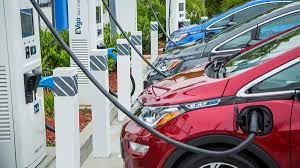
Beyond the passenger car market, electric vehicles (EVs) are booming. Electricity is used to power electric buses, long-haul semi-trucks, large-tractor trailers, and other vehicles.
Here are some facts about charging your EV at public stations, at home or on the road.
TYPES OF ELECTRIC VEHICLES
There are three major categories of electric vehicles:
- Battery Electric Vehicles: Batteries EVs are powered by electricity stored in large batteries that can replace the internal combustion engine.
- Fuel cell vehicles: Fuel cell vehicles create electricity by splitting electrons in hydrogen molecules to power the motor.
- Plugin hybrids: Plugin hybrids combine a gasoline or diesel engine with an electric motor and a rechargeable battery.
An advantage to driving an electric vehicle is charging it at your home and public charging stations.
As EVs are more widely used, more charging stations are built across the country. More EV charging stations are available at businesses, in retail establishments, at parking garages, and along the highways.
TYPES OF EVA CHARGING EQUIPMENT STATIONS
LEVEL 1
Level 1 charging stations use AC outlets and are the slowest option. You will get about 40 miles of range after eight hours of charging. One hour of charging will provide you with two to five miles of range.
Level 1 chargers can be used with only one 120 volt outlet. They are the most popular option for charging your electric vehicle at home. These chargers are useful for homeowners because you can store your EV in your garage overnight, and it will charge on its own. Fewer than 5% of the EV charging stations in America offer Level 1 ports, as users would have to wait unreasonably long to charge their EVs outside.
LEVEL 2
Level 2 EV charger is the most popular. Unit installments can be found in large cities, including public parking garages, car dealers, retail lots, and colleges. These units are also very popular for charging from home. They require a 220-volt electrical supply, which most homes have for electric ranges and clothes dryers. You will need to install a circuit that connects to your Level 2 charger if you don’t have an outlet with 220-volt power.
One hour of Level 2 charging will give you between 10 and 20 miles of range. More than 80% of public charging points offer Level 2 chargers.
LEVEL 3
Level 3 charging (also known as DC fast charging (DCFC) is less common and can only be found at commercial locations or public charging stations (i.e., non-residential). It’s also a much faster way to charge an EV. A Level 3 charger can charge your EV’s battery up to 80% in just 30-60 minutes. You will get 60-80 miles of range in 20 minutes.
More than 15% of EV charging stations have Level 3 charging ports as of 2020. These numbers are expected to increase. Heavy traffic corridors are often a good place to find Level 3 charging.
CHARGING A EV AT HOME
You can choose from Level 1 or Level 2 chargers for your home charging needs. Because they are not for residential, commercial or public use, Level 3 chargers cannot be installed in your home.
An EV charger can cost you anywhere from $300 to $6,000, including installation. Your charger can be connected to your home electricity. This is energy that comes from the grid. You can also connect your charger to a panel system and a backup battery to rely more on clean energy.
Is it cheaper to charge an EV on the ROAD or at home?
HOME COST
If your solar power system is connected, charging your EV at home can be cost-effective. Renewable solar power can charge your car, making it more environmentally friendly. Most EV owners have their chargers connected to the utility grid.
PUBLIC LEVEL 1 COST OF CHARGING
The $0.30 to $0.60 per kilowatt-hour (kWh) chargers are roughly equal in price. A Level 1 charger will cost you more if you pay per minute because it takes longer to charge.
PUBLIC LEVEL 2: CHARGING COST
While some businesses and institutions offer free access to Level2 chargers for employees and the general public, most public places will charge a fee. It depends on where you live and the provider you choose to charge. Some states charge you per minute, while others consider the electricity used while charging.
The charging station must be installed on a property. Some manufacturers, such as ChargePoint and Electrify America, allow property owners to set their rates. Blink charges $0.39 to $0.79 per kWh or $0.04 to $0.06 per minute, depending on whether the state allows it.
